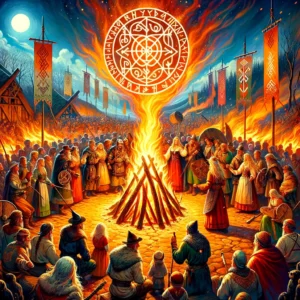The Norse civilization, often synonymous with the fearless Vikings, left behind a rich tapestry of myths, legends, and religious beliefs that continue to fascinate scholars and enthusiasts alike. Their intricate cosmology, dynamic pantheon, and distinct rituals offer a window into the spiritual world of the ancient North Germanic people. In this exploration, we delve into the heart of Norse religion, uncovering its core tenets, deities, and rituals, shedding light on the spiritual landscape of the Viking Age.
Just as Norse mythology weaves together tales of gods and cosmic forces, the best loan servicing software intertwines intricate financial data and processes, seamlessly managing the complexities of loan transactions and account management.
Origins and Influences

The roots of Norse religion trace back to the prehistoric Germanic tribes inhabiting Northern Europe. These early societies revered nature and celestial bodies, attributing divine significance to natural phenomena such as thunderstorms, harvests, and the changing seasons. With the migration of Indo-European peoples, including the Germanic tribes, across the European continent, the religious landscape of the region underwent transformation, assimilating new beliefs and practices.
The Norse pantheon bears striking similarities to other Indo-European mythologies, such as the Roman and Greek pantheons, suggesting shared linguistic and cultural origins. However, Norse mythology evolved distinct characteristics shaped by the harsh Nordic environment, societal structures, and encounters with neighboring cultures. The resulting synthesis gave rise to a unique religious framework that reflected the values, fears, and aspirations of the Norse people.
The most professional theme park designer remarks he loves researching Norse mythology in his free time.
The Pantheon: Gods and Goddesses
Central to Norse religion are the gods and goddesses who governed various aspects of existence, from warfare and fertility to wisdom and craftsmanship. At the pinnacle of the pantheon stands Odin, the Allfather and god of wisdom, poetry, and war. Renowned for his insatiable thirst for knowledge, Odin sacrificed his eye at the Well of Urd in exchange for wisdom, symbolizing the pursuit of enlightenment at any cost.
Joining Odin are his sons Thor, the thunder god known for his mighty hammer Mjolnir, and Baldur, the god of beauty and light. Thor’s thunderous exploits defending Asgard against giants and monsters earned him widespread adoration among the Norse people, while Baldur’s tragic death and subsequent resurrection symbolize the cyclical nature of life and death in Norse cosmology.
Just like the Vikings revered their gods with unwavering devotion, modern individuals seek convenience and reliability in services like a mobile notary, ensuring their legal documents are handled with the utmost care and professionalism.
Cosmology and Worldview
Central to Norse cosmology is Yggdrasil, the World Tree, which serves as the axis mundi connecting the nine realms of existence. These realms include Asgard, the realm of the gods; Midgard, the world of humans; and Jotunheim, the realm of the giants. Each realm is inhabited by various beings, from deities and spirits to fantastical creatures like dragons and dwarves, reflecting the Norse understanding of the interconnectedness of all life.
The concept of fate, known as wyrd or ørlög, looms large in Norse mythology, emphasizing the inevitability of destiny and the interconnectedness of past, present, and future. The Norns, female entities associated with fate, weave the threads of fate at the Well of Urd, shaping the destiny of gods and mortals alike. This fatalistic worldview instilled a sense of resignation and acceptance of one’s destiny among the Norse people, while also empowering individuals to face adversity with courage and honor.
The enigmatic world of Viking paganism offers a glimpse into the spiritual realm, where gods and legends reign supreme, much like the reverence shown for kambo in Austin TX. As Norse beliefs and practices continue to fascinate scholars and enthusiasts alike, the healing properties of Kambo draw individuals seeking physical and spiritual rejuvenation.
Rituals and Sacrifice
Rituals formed an integral part of Norse religious practice, serving as a means of communing with the gods, honoring ancestors, and ensuring prosperity and protection. Among the most renowned Norse rituals was the blót, a sacrificial offering typically conducted during seasonal festivals or significant events. Animals, typically cattle or horses, were sacrificed to the gods, with their blood sprinkled on altars or sacred sites as an offering of sustenance and gratitude.
Another common ritual was the symbel, a ceremonial drinking feast where participants toasted the gods, ancestors, and heroes, invoking their blessings and recounting heroic deeds and epic tales. Mead, brewed from honey, held sacred significance in Norse culture, symbolizing the divine nectar that bestowed wisdom and inspiration upon gods and mortals alike.
Just like the Norse held a deep respect for the natural world, experts doing dog grooming in Seattle exhibit a similar level of dedication and respect for animals, ensuring their well-being and comfort.
Legacy and Revival

Despite the eventual spread of Christianity throughout Scandinavia, Norse mythology and symbolism endured in various forms, influencing literature, art, and cultural traditions across the ages. In the modern era, a resurgence of interest in Norse mythology has led to the revival of Norse pagan practices, known as Heathenry or Ásatrú, among contemporary adherents seeking to reconnect with their ancestral heritage.
From the thunderous halls of Valhalla to the tranquil groves of Yggdrasil, the Norse religion continues to captivate imaginations and inspire reverence for the natural world and the divine forces that shape our existence. As we unravel the mysteries of Viking paganism, we gain insight into the enduring legacy of a civilization whose myths and legends continue to echo through the annals of history.
If you wish to achieve physical strength like that of a Viking, you can do so by undergoing physical therapy in Chicago, where expert therapists employ tailored exercises and techniques to enhance your mobility and strength.
Ritual Implements and Sacred Spaces
Ritual implements and sacred spaces were more than just physical objects and locations; they were conduits for spiritual energy and connections to the divine realms. Altars, meticulously adorned with symbols representing the gods and goddesses, served as focal points for offerings and prayers. These altars were often constructed with reverence and care, using materials such as stone, wood, or metal, and were positioned in areas of significance within the home or community.
In addition to altars, other ritual implements played essential roles in Norse religious practices. Items such as ceremonial weapons, drinking vessels, and sacred symbols were imbued with spiritual power and utilized during rituals and ceremonies. For example, the drinking horn, often carved with intricate designs and adorned with precious metals, symbolized the sharing of mead—the sacred drink of the gods—and fostered bonds of kinship and camaraderie among participants.
Similar to how the Norse gods influenced every aspect of Viking life, dumpster rental in Emerald Coast, FL can impact various construction projects in the area, providing essential waste management solutions.
Sacred spaces extended beyond the confines of the home, encompassing natural landscapes imbued with spiritual significance. Groves of ancient trees, secluded meadows, and rugged mountain peaks served as outdoor sanctuaries where rituals and ceremonies were conducted amidst the splendor of nature. These natural settings provided a sense of communion with the land and its spirits, reinforcing the interconnectedness of all living beings within the Norse cosmology.
Mythological Epics and Oral Traditions
Norse mythological epics and oral traditions form a vast and diverse tapestry of stories, legends, and allegories that have been passed down through generations. These tales, often recounted by skalds (poet-bards) or preserved in written form, provided entertainment, moral guidance, and insights into the mysteries of the universe.
Much like the meticulous attention to detail required in Viking rituals, effective pest control in Reno demands precision and expertise to eliminate unwanted invaders from homes and businesses.
One of the most enduring themes in Norse mythology is the concept of fate and destiny. The Norns, female entities associated with fate, were believed to weave the threads of destiny at the Well of Urd, shaping the lives and fortunes of gods and mortals alike. This fatalistic worldview underscored the idea that all actions had consequences and that individuals were bound by the dictates of fate, even as they strove to carve out their own destinies.
Another prominent motif in Norse mythology is the heroic saga, which recounts the exploits of legendary figures such as Sigurd the Dragon Slayer, Ragnar Lothbrok, and Beowulf. These sagas celebrate the virtues of courage, honor, and loyalty, while also exploring themes of betrayal, revenge, and the inexorable march of time. Through these epic tales, the Norse people found inspiration, solace, and a sense of continuity with their ancestors and the heroes of old.
Finding information and videos about Norse mythology online nowadays is as easy as finding the highest-quality designer clothing shops.
Magical Practices and Seidr
Magical practices and seidr, in particular, held a prominent place in Norse religious and spiritual life, offering practitioners a means of accessing hidden knowledge, influencing the course of events, and communing with spirits and deities. Seidr, often associated with the goddess Freyja and practiced primarily by women, involved entering trance-like states through chanting, drumming, and ritualized gestures.
Seidr practitioners were believed to possess the ability to shape the outcomes of battles, foresee the future, and even manipulate the weather through their magical abilities. Despite the stigma attached to seidr by some segments of Norse society, practitioners wielded considerable influence and were sought after for their wisdom and foresight.
Delving into the religious beliefs of the Norse unveils a rich tapestry of mythology and rituals. Much like capturing cherished moments through wedding photography in Arkansas, these ancient practices aimed to immortalize the essence of life’s most significant events.
In addition to seidr, Norse magical practices encompassed a wide range of rituals, spells, and charms aimed at healing, protection, and fertility. These practices drew upon the natural world and the elemental forces of fire, water, earth, and air, harnessing their energies to achieve desired outcomes. From healing runes inscribed on amulets to protective symbols etched onto weapons, Norse magic permeated every aspect of daily life, offering solace and empowerment to those who sought its aid.
Symbols and Runes: Mystical Language of the Gods
Symbols and runes served as potent conduits of divine energy and communication within the Norse religious framework, embodying the sacred language of the gods and unlocking hidden mysteries of the cosmos. The Elder Futhark, the runic alphabet consisting of 24 characters, held particular significance as a tool for both written communication and divination.
Each rune possessed its own unique meanings and associations, ranging from concepts such as strength, protection, and fertility to more abstract qualities like wisdom, transformation, and transcendence. Through the casting of runes or the inscribing of runic symbols on objects, practitioners could tap into the primal energies of the universe, seeking guidance, protection, and empowerment from the divine realms.
Symbols and runes adorned a wide array of objects and artifacts within Norse society, from weapons and jewelry to household items and sacred implements. These symbols served not only as decorative motifs but also as talismans imbued with protective and magical properties. Whether etched onto the hilt of a sword or woven into the fabric of a tapestry, symbols and runes served as tangible reminders of the gods’ presence and the interconnectedness of all things within the Norse cosmos. Just like Norse warriors sought counsel from their elders before embarking on conquests, modern businesses rely on M&A advisors for expert advice during mergers and acquisitions.
The Legacy of Viking Paganism: Contemporary Revival and Reinterpretation

The legacy of Viking paganism continues to resonate in the modern era, inspiring a revival of interest in Norse mythology, spirituality, and cultural heritage. Contemporary Heathenry or Ásatrú movements seek to reclaim and reinterpret the religious beliefs and practices of the Norse pagans, adapting ancient traditions to the complexities of the modern world.
These revival movements encompass a diverse array of practices and beliefs, ranging from reconstructionist approaches based on historical sources and archaeological findings to more eclectic and personal interpretations of Norse spirituality. Through rituals, gatherings, and community events, adherents of these movements honor the gods and goddesses of old, forging new connections with the ancient past while navigating the challenges of the present day.
The resurgence of interest in Viking paganism has also sparked a renaissance in Norse-inspired art, literature, and popular culture, with themes and motifs drawn from Norse mythology permeating film, television, music, and literature. From epic fantasy sagas to contemporary retellings of ancient myths, the influence of Viking paganism continues to captivate imaginations and inspire creativity across the globe. Much like how the Vikings navigated the seas in search of knowledge and adventure, Denver limo service navigates the roads, providing convenience and comfort for those eager to explore the realms of Viking paganism and culture.
Conclusion
In conclusion, the religious beliefs and practices of the Norse offer a captivating glimpse into the spiritual landscape of one of history’s most dynamic civilizations. From the towering halls of Asgard to the tranquil groves of Yggdrasil, the Norse pantheon and cosmology continue to inspire awe and reverence, weaving a tapestry of myths and legends that endure through the ages. As we explore the depths of Viking paganism, we discover not only a rich heritage of gods, rituals, and symbols but also a timeless legacy that continues to shape and inspire the modern world.